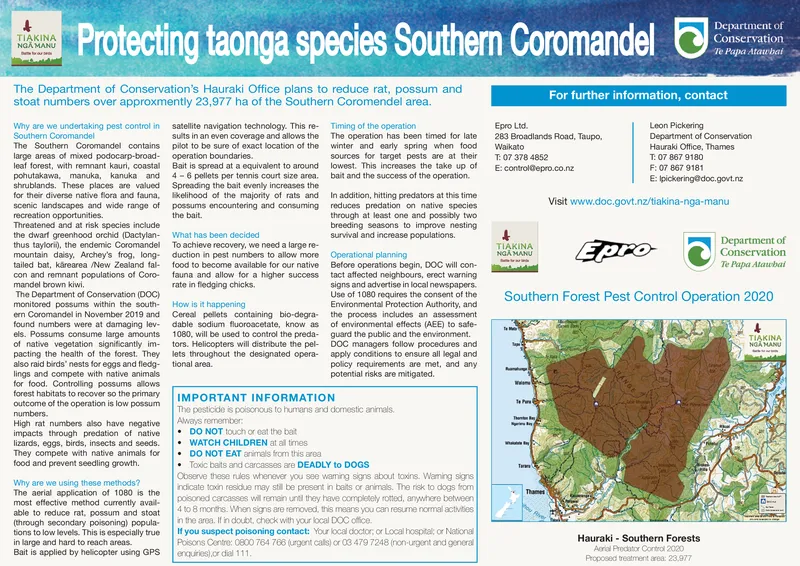Advertisement

-
Published Date
September 4, 2020This ad was originally published on this date and may contain an offer that is no longer valid. To learn more about this business and its most recent offers, click here.
Ad Text
Protecting taonga species Southern Coromandel Department of Conservation Te Papa Atarbai TIAKINA NGA MANU The Department of Conservation's Hauraki Office plans to reduce rat, possum and stoat numbers over approxmently 23,977 ha of the Southern Coromendel area. For further information, contact Why are we undertaking pest control in satellite navigation technology. This re- Timing of the operation Southern Coromandel Epro Ltd. 283 Broadlands Road, Taupo, Leon Pickering Department of Conservation Hauraki Office, Thames sults in an even coverage and allows the The operation has been timed for late The Southern Coromandel contains pilot to be sure of exact location of the winter and early spring when food large areas of mixed podocarp-broad- leaf forest, with remnant kauri, coastal Waikato sources for target pests are at their operation boundaries. Bait is spread at a equivalent to around lowest. This increases the take up of 4 - 6 pellets per tennis court size area. T: 07 378 4852 T: 07 867 9180 F: 07 867 9181 E: Ipickeringedoc.govt.nz E: control@epro.co.nz pohutakawa, manuka, kanuka and shrublands. These places are valued Spreading the bait evenly increases the for their diverse native flora and fauna, bait and the success of the operation. likelihood of the majority of rats and In addition, hitting predators at this time Visit www.doc.govt.nz/tiakina-nga-manu scenic landscapes and wide range of possums encountering and consuming reduces predation on native species recreation opportunities. Threatened and at risk species include the dwarf greenhood orchid (Dactylan- What has been decided thus taylori), the endemic Coromandel mountain daisy, Archey's frog, long- duction in pest numbers to allow more Operational planning tailed bat, karearea /New Zealand fal- food to become available for our native Before operations begin, DOC will con- con and remnant populations of Coro- mandel brown kiwi. the bait. through at least one and possibly two breeding seasons to improve nesting survival and increase populations. Epro Department of Conservation To achieve recovery, we need a large re- TIAKINA NGA MANU Te Papa Ataubal fauna and allow for a higher success tact affected neighbours, erect warning signs and advertise in local newspapers. Use of 1080 requires the consent of the Environmental Protection Authority, and Cereal pellets containing bio-degra- the process includes an assessment rate in fledging chicks. The Department of Conservation (DOC) monitored possums within the south- How is it happening ern Coromandel in November 2019 and Southern Forest Pest Control Operation 2020 found numbers were at damaging lev- dable sodium fluoroacetate, know as of environmental effects (AEE) to safe- els. Possums consume large amounts of native vegetation significantly im- tors. Helicopters will distribute the pel- DOC managers follow procedures and pacting the health of the forest. They lets throughout the designated opera- apply conditions to ensure all legal and also raid birds' nests for eggs and fledg- tional area. lings and compete with native animals for food. Controlling possums allows forest habitats to recover so the primary outcome of the operation is low possum 1080, will be used to control the preda- guard the public and the environment. TIAKINA NGÀ MANU policy requirements are met, and any potential risks are mitigated. Wwem IMPORTANT INFORMATION The pesticide is poisonous to humens and domestic animals. Aways remember: DO NOT touch or eat the bat WATCH CHILDREN at all times DO NOT EAT animels from this area Toxic bats and carcasses are DEADLY to DOGS Observe these nules whenever you see waming signs about toxirs. Waming signs indicate toin residue may still be presert in bats or animels. The risk to dogs from posoned carcasses will remein unti they have completely rotted, anywhere between 4 to 8 moniths. When signs are removed, this means you can resume nomal activites in the area. If in doubt, check with your local DOC office. If you suspect poisoning contact: Your local doctor, or Local hospta, or National Poisons Centre: 0800 764 766 (ugont cals) or 03 4797248 (non-urgent and general enquiries).or dial 111, Te Parre "SJaqunu High rat numbers also have negative impacts through predation of native lizards, eggs, birds, insects and seeds. They compete with native animals for food and prevent seedling growth. The Te Why are we using these methods? The aerial application of 1080 is the most effective method currently avail- able to reduce rat, possum and stoat (through secondary poisoning) popula- tions to low levels. This is especially true in large and hard to reach areas. Bait is applied by helicopter using GPS Thames Hauraki - Southern Forests Aprial Prodator Control 2020 Proposed treatment area: 23.977 Protecting taonga species Southern Coromandel Department of Conservation Te Papa Atarbai TIAKINA NGA MANU The Department of Conservation's Hauraki Office plans to reduce rat, possum and stoat numbers over approxmently 23,977 ha of the Southern Coromendel area. For further information, contact Why are we undertaking pest control in satellite navigation technology. This re- Timing of the operation Southern Coromandel Epro Ltd. 283 Broadlands Road, Taupo, Leon Pickering Department of Conservation Hauraki Office, Thames sults in an even coverage and allows the The operation has been timed for late The Southern Coromandel contains pilot to be sure of exact location of the winter and early spring when food large areas of mixed podocarp-broad- leaf forest, with remnant kauri, coastal Waikato sources for target pests are at their operation boundaries. Bait is spread at a equivalent to around lowest. This increases the take up of 4 - 6 pellets per tennis court size area. T: 07 378 4852 T: 07 867 9180 F: 07 867 9181 E: Ipickeringedoc.govt.nz E: control@epro.co.nz pohutakawa, manuka, kanuka and shrublands. These places are valued Spreading the bait evenly increases the for their diverse native flora and fauna, bait and the success of the operation. likelihood of the majority of rats and In addition, hitting predators at this time Visit www.doc.govt.nz/tiakina-nga-manu scenic landscapes and wide range of possums encountering and consuming reduces predation on native species recreation opportunities. Threatened and at risk species include the dwarf greenhood orchid (Dactylan- What has been decided thus taylori), the endemic Coromandel mountain daisy, Archey's frog, long- duction in pest numbers to allow more Operational planning tailed bat, karearea /New Zealand fal- food to become available for our native Before operations begin, DOC will con- con and remnant populations of Coro- mandel brown kiwi. the bait. through at least one and possibly two breeding seasons to improve nesting survival and increase populations. Epro Department of Conservation To achieve recovery, we need a large re- TIAKINA NGA MANU Te Papa Ataubal fauna and allow for a higher success tact affected neighbours, erect warning signs and advertise in local newspapers. Use of 1080 requires the consent of the Environmental Protection Authority, and Cereal pellets containing bio-degra- the process includes an assessment rate in fledging chicks. The Department of Conservation (DOC) monitored possums within the south- How is it happening ern Coromandel in November 2019 and Southern Forest Pest Control Operation 2020 found numbers were at damaging lev- dable sodium fluoroacetate, know as of environmental effects (AEE) to safe- els. Possums consume large amounts of native vegetation significantly im- tors. Helicopters will distribute the pel- DOC managers follow procedures and pacting the health of the forest. They lets throughout the designated opera- apply conditions to ensure all legal and also raid birds' nests for eggs and fledg- tional area. lings and compete with native animals for food. Controlling possums allows forest habitats to recover so the primary outcome of the operation is low possum 1080, will be used to control the preda- guard the public and the environment. TIAKINA NGÀ MANU policy requirements are met, and any potential risks are mitigated. Wwem IMPORTANT INFORMATION The pesticide is poisonous to humens and domestic animals. Aways remember: DO NOT touch or eat the bat WATCH CHILDREN at all times DO NOT EAT animels from this area Toxic bats and carcasses are DEADLY to DOGS Observe these nules whenever you see waming signs about toxirs. Waming signs indicate toin residue may still be presert in bats or animels. The risk to dogs from posoned carcasses will remein unti they have completely rotted, anywhere between 4 to 8 moniths. When signs are removed, this means you can resume nomal activites in the area. If in doubt, check with your local DOC office. If you suspect poisoning contact: Your local doctor, or Local hospta, or National Poisons Centre: 0800 764 766 (ugont cals) or 03 4797248 (non-urgent and general enquiries).or dial 111, Te Parre "SJaqunu High rat numbers also have negative impacts through predation of native lizards, eggs, birds, insects and seeds. They compete with native animals for food and prevent seedling growth. The Te Why are we using these methods? The aerial application of 1080 is the most effective method currently avail- able to reduce rat, possum and stoat (through secondary poisoning) popula- tions to low levels. This is especially true in large and hard to reach areas. Bait is applied by helicopter using GPS Thames Hauraki - Southern Forests Aprial Prodator Control 2020 Proposed treatment area: 23.977
